Fungus on a log in a pocosin cypress swamp:
Red:
Continue reading
Dogs in the swamp
Brown Dog, Yellow Dog,
John S. Quarterman, Gretchen Quarterman,
Video by John S. Quarterman for Okra Paradise Farms, Lowndes County, Georgia, 21 April 2013.
-jsq
 Nature is not something
out there, apart from people.
It never was, and nowadays people have built and farmed and clearcut
so much that wildlife species from insects to birds are in trouble.
In south Georgia people may think that our trees make a lot of wildlife habitat.
Actually, most of those trees are planted pine plantations with
very limited undergrowth, and in town many yards are deserts of grass
plus exotic species that don’t support native birds.
Douglas Tallamy offers one solution:
turn yards into wildlife habitat by growing native species.
Since we are as always remodeling nature, we might as well do it
so as to feed the rest of nature and ourselves,
and by the way get flood prevention and possibly cleaner water as well,
oh, and fewer pesticides to poison ourselves.
Nature is not something
out there, apart from people.
It never was, and nowadays people have built and farmed and clearcut
so much that wildlife species from insects to birds are in trouble.
In south Georgia people may think that our trees make a lot of wildlife habitat.
Actually, most of those trees are planted pine plantations with
very limited undergrowth, and in town many yards are deserts of grass
plus exotic species that don’t support native birds.
Douglas Tallamy offers one solution:
turn yards into wildlife habitat by growing native species.
Since we are as always remodeling nature, we might as well do it
so as to feed the rest of nature and ourselves,
and by the way get flood prevention and possibly cleaner water as well,
oh, and fewer pesticides to poison ourselves.
Douglas Tallamy makes a clear and compelling case in
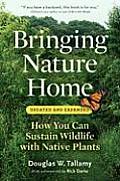 Bringing Nature Home: How You Can Sustain Wildlife with Native Plants
Bringing Nature Home: How You Can Sustain Wildlife with Native Plants
…it is not yet too late to save most of the plants and animals that sustain the ecosystems on which we ourselves depend. Second, restoring native plants to most human-dominated landscapes is relatively easy to do.
Some of you may wonder why native species are so important? Don’t we have more deer than we can shoot? Maybe so, but we have far fewer birds of almost every species than we did decades and only a few years ago.
Some may wonder: aren’t exotic species just as good as native ones,
if deer and birds can eat them?
Actually, no, because many exotic species are poisonous
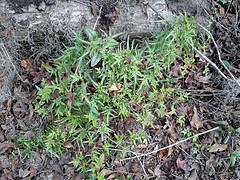 to native wildlife, and because invasive exotics crowd out natives
and reduce species diversity.
From kudzu to
Japanese climbing fern, exotic invasives are bad for wildlife
and may also promote erosion and flooding by strangling native vegetation.
to native wildlife, and because invasive exotics crowd out natives
and reduce species diversity.
From kudzu to
Japanese climbing fern, exotic invasives are bad for wildlife
and may also promote erosion and flooding by strangling native vegetation.
All plants are not created equal, particularly in their ability to support wildlife. Most of our native plant-eaters are not able to eat alien plants, and we are replacing native plants with alien species at an alarming rate, especially in the suburban gardens on which our wildlife increasingly depends. My central message is that unless we restore native plants to our suburban ecosystems, the future of biodiversity in the United States is dim.
Tallamy had an epiphany when he and his wife moved to 10 acres in Pennsylvania in 2000:
Continue reading
Higher average temperatures
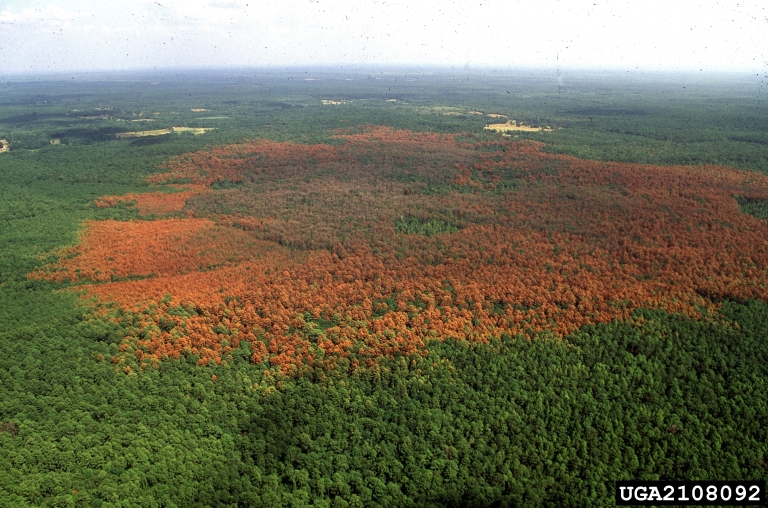 mean much more frequent droughts and trees dying faster in droughts
because of the temperatures.
That plus pine beetles, according to research from 2009.
Forestry is Georgia’s second largest industry
in terms of
employment and wages and salaries,
more than $28 billion a year
according to the Georgia Forestry Commission,
plus an estimated
$36 billion a year in ecosystem services
such as water filtration, carbon storage, wildlife habitat, and aesthetics,
not to mention hunting and fishing.
Climate change matters to Georgia’s forests and to Georgia.
mean much more frequent droughts and trees dying faster in droughts
because of the temperatures.
That plus pine beetles, according to research from 2009.
Forestry is Georgia’s second largest industry
in terms of
employment and wages and salaries,
more than $28 billion a year
according to the Georgia Forestry Commission,
plus an estimated
$36 billion a year in ecosystem services
such as water filtration, carbon storage, wildlife habitat, and aesthetics,
not to mention hunting and fishing.
Climate change matters to Georgia’s forests and to Georgia.
The paper appeared 13 April 2009 in the Proceedings of the National Academy of the Sciences, Temperature sensitivity of drought-induced tree mortality portends increased regional die-off under global-change-type drought, by Henry D. Adams, Maite Guardiola-Claramonte, Greg A. Barron-Gafford, Juan Camilo Villegas, David D. Breshears, Chris B. Zou, Peter A. Troch, and Travis E. Huxman, 106(17) 7063-7066, doi: 10.1073/pnas.0901438106.
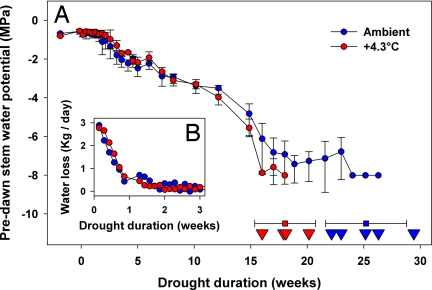
All drought trees in the warmer treatment died before any of the drought trees in the ambient treatment (on average 18.0 vs. 25.1 weeks, P <0.01; Fig. 1A).
They say warmer trees dying faster in drought wasn’t due to a difference in amount of water. Instead, they infer the warmer trees couldn’t breathe.
Combined, our results provide experimental evidence that piñon pines attempted to avoid drought-induced mortality by regulating stomata and foregoing further photosynthesis but subsequently succumbed to drought due to carbon starvation, not sudden hydraulic failure. Importantly, we isolate the effect of temperature from other climate variables and biotic agents
and show that the effect of warmer temperature in conjunction with drought can be substantial.
Our results imply that future warmer temperatures will not only increase background rates of tree mortality (13, 16), but also result in more frequent widespread vegetation die-off events (3, 35) through an exacerbation of metabolic stress associated with drought. With warmer temperatures, droughts of shorter duration—which occur more frequently—would be sufficient to cause widespread die-off.
How much more frequently?
They calculated an estimate for that, too: five times more frequently.
Of course, that’s for the specific kinds of forests they were studying,
and the exact number may vary, but the general trend is clear:
higher temperatures mean more frequent droughts,
like
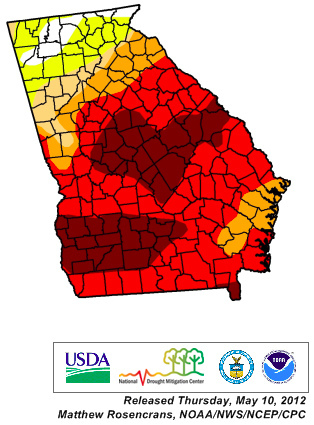 the year-long drought we just experienced in south Georgia.
the year-long drought we just experienced in south Georgia.
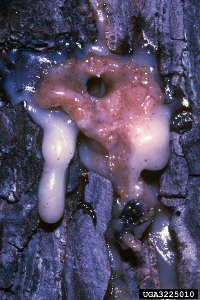
This projection is conservative because it is based on the historical drought record and therefore does not include changes in drought frequency, which is predicted to increase concurrently with warming (2, 37—39). In addition, populations of tree pests, such as bark beetles, which are often the proximal cause of mortality in this species and others, are also expected to increase with future warming (7, 9, 38).
Bark beetles, such as the ones that bored into this 19 inch slash pine
and spread from there to twenty others I had to cut down to prevent further spread
of the pine beetles.
What happens when pine beetles spread
is what you see in the
first picture in this post:
acres and acres of dead red pine trees.
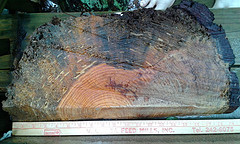 Monoculture slash pine plantations may show this effect most clearly,
but look around here, and you’ll see red dead loblolly and longleaf pines,
too.
Monoculture slash pine plantations may show this effect most clearly,
but look around here, and you’ll see red dead loblolly and longleaf pines,
too.
The article is saying that if the beetles don’t get the trees weakened by droughts that will be much more frequent, the trees will die more quickly of suffocation, because the temperature is higher. Higher temperatures is something that should concern every Georgian in our state where forestry is the second largest industry and our forests protect our wildlife and the air that we breathe and the water that we drink.
-jsq
Want better yields and the same or more profit? Stop buying pesticides, rotate more crops over longer periods, and mix in animals. Yet another study confirms this. Oh, and a hundred times less disease-causing pesticides in streams, and presumably also less pesticides in the food going to market.
Mark Bittman wrote for NYTimes today, A Simple Fix for Farming,
The study was done on land owned by Iowa State University called the Marsden Farm. On 22 acres of it, beginning in 2003, researchers set up three plots: one replicated the typical Midwestern cycle of planting corn one year and then soybeans the next, along with its routine mix of chemicals. On another, they planted a three-year cycle that included oats; the third plot added a four-year cycle and alfalfa. The longer rotations also integrated the raising of livestock, whose manure was used as fertilizer.
The paper’s Figure 3 (above) illustrates that labor increased with crop rotation length, but so did yield, and profit remained the same or better. How can this be? Continue reading
 Back at the end of March at
a river conference in Roswell, Georgia,
I was interviewed for a podcast.
Here’s
the audio,
and here’s the blurb they included:
Back at the end of March at
a river conference in Roswell, Georgia,
I was interviewed for a podcast.
Here’s
the audio,
and here’s the blurb they included:
John Quarterman on the Withlachoochee
Monday, July 9th, 2012
John S. Quarterman was born and raised in Lowndes County, where he married his wife Gretchen. They live on the same land where he grew up, and participate in local community and government.
NPS talks with Quarterman and his observations on starting and strengthening a Withlachoochee Riverkeeper organization at Georgia River Network‘s 2012 Weekend for Rivers.
The water organization has since been incorporated as the Georgia non-profit WWALS Watershed Coalition:
WWALS is an advocacy organization working for watershed conservation of the Willacoochee, Withlacoochee, Alapaha, and Little River Systems watershed in south Georgia and north Florida through awareness, environmental monitoring, and citizen advocacy.
-jsq
PS: They also recorded another podcast which starts out on what may sound like a completely different topic, but which is actually quite related.
 Sounds you don't want your smart phone to make: "Plop!" as it falls out of your pocket into the pond.
Sounds you don't want your smart phone to make: "Plop!" as it falls out of your pocket into the pond.
Now you might think it would be easy to find, since you can plainly see it fell straight down. Nope, I've rummaged through the bottom all around with fingers, then with a potato fork. Nothing. I blame it on the beavers, who I think are facebooking with it.
Here's the video:
Plop!
Video of John S. Quarterman by Gretchen Quarterman for Okra Paradise Farms, Lowndes County, Georgia, 22 April 2012.
-jsq
We already knew nature makes healthy. Here’s a group helping nature help troubled youth make nature healthy.
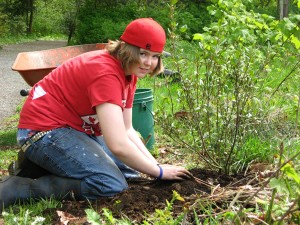 From the website of Youth and Ecological Restoration Program:
From the website of Youth and Ecological Restoration Program:
Planting native trees and shrubs in local watersheds provides habitat and protection for fish, birds and many other species.
Stephen Hume wrote for the Vancouver Sun yesterday, Healing power of troubled waters: An ecological program that links at-risk teens with damaged watersheds has breathed new life into both,
Continue readingAfter Carnation Creek, Wendy applied and was accepted at university as a mature student, successfully studying ecology and land reclamation, presenting her own scientific papers. Then, eight years ago, she began putting her wisdom to work teaching the next generation to pay attention to the consequences of heedlessness, greed and ignorance about our dependence on the natural world.
Her innovative Youth and Ecological Restoration Program helps teenagers at risk. Some struggle with